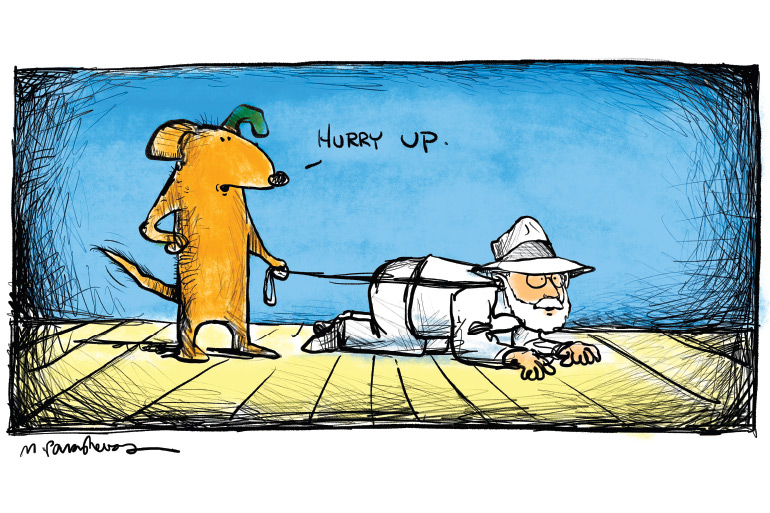Hamptons Dogs: Beloved Bee Bee Who Helped Deliver Mail & Other Tales

The first time I had a dog in the Hamptons was in the 1960s. On the first day, I taught him to walk beside me without a leash. The second day I had this dog, I was walking down Newtown Lane with him, talking to a friend, when he ran off. The two of us began looking for him, going up and down the street and its alleys, shouting “Scampi!”
Scampi was his name. Strangers took up the call to help us, and after about 10 minutes of this he came trotting happily out of what today is the Stop & Shop, wagging his tail. He’d had a good time in there. Now he wanted to go home.
But first I wanted to go in with him to thank the people who had helped him out. Everyone inside was amused by him. He was a handsome sheepdog, after all. A butcher patted him and gave him a bone to chew on.
“Who gave him that silly name?” a checkout girl asked. I told her I did not know. There had been a prior owner.
Scampi lived a long and happy life in East Hampton. He ran free. He knew enough to not run out into the street. And at the end of every day, he came home.
In 1974, Bee Bee, a beloved collie-sheepdog mix in Southampton, died. His photo was on the front page of The Southampton Press that week. Bee Bee would leave his home on Windmill Lane, run down to the post office on Nugent Street every morning, and then follow the postman who came out with a pull cart full of mail to deliver to all the store owners in town on Jobs Lane, Main Street, Nugent Street and Willow. For years, he had been doing this. People loved him and petted him. He knew the route well and often would joyfully go on ahead to the next stop, get a pat, perhaps a treat, then come back. It was his job. I did not know this dog, but I read all the comments by merchants and others along the route who were now so sad.

We did have a dog like this in East Hampton around that time. He was a Scottie who lived at the home of the Nigel Young family on Woods Lane, and in the mornings he’d go out on the downtown mail route. Mrs. Young was a real estate agent for Connie Lamb. Nigel was a retired British World War II spitfire pilot. The house was two doors down from the Jewish Center of the Hamptons. It was also a big deal when their dog died. Ten years later, Mr. Young died. He was flying along the beach at a low altitude in an antique warplane when his plane hit a flock of birds and went down. He was a nice guy and widely mourned.
The laws about dogs in the Hamptons began to change in the 1980s. A new law was written in East Hampton that said dogs needed to be under a person’s control at all times. He could be off-leash, of course. As long as he would come when you called, it would be okay.
It was during this time that I adopted a lovable sheepdog named Wags. The Animal Rescue Fund of the Hamptons (ARF) had started. When we’d be out and about in crowds, he loved to run around and try to round them up. Most crowds didn’t want to be rounded up. But when I called, he’d come running.
He was also a watchdog about anything that had to do with our house. One Saturday we held a yard sale. Every once in a while, some people would park on the street, then walk up the 50-yard-long paved driveway leading up to the garage to look at all the stuff laid out there. Wags would lie down at the top of the driveway, looking down toward the street and waiting for intruders. When people would get out of their cars down there, he’d get up, run down the driveway and herd them up to the garage, barking and wagging his tail. He did this for several hours before he began to tire. It was a hot day. In the early afternoon he’d see people get out of their cars and he’d just raise his head and bark at them as they came up. After a while, tiring of that, he simply lay there. Enough was enough.
The laws changed further. Local baymen with pickup trucks had been driving down to the beach for generations to throw nets into the ocean from oversized rowboats. They called this haul seining. Almost every one of them had Labrador Retrievers running around loose in the flat bed, enjoying the ride. Make a sharp right turn and they’d fight not to skid across the flatbed, and wag their tails. They were out enjoying the sunshine, the ride and the fishing to come. The town passed a new law. Those dogs in back had to be attached to a bungee cord, and the bungee cord attached to a cleat inside the flatbed. Some summer people had contacted the town to tell officials that they had been driving behind these pickups and were afraid those dogs would skid off the trucks. (It had never happened.) So now, dogs with bungee cords.
Around 2005, a friend who lived in a small shack down at the beach in Amagansett called to tell me that his German Shepherd had been arrested.
“They were men in uniforms. Animal Control. They didn’t care he had a collar with a license. All his life, he’d been running off every day and stay out until dinnertime. He’d be in town or down at the beach. Atlantic Avenue was his beach. Everyone loves him. And now they want me to pay a $100 fine and never let him down there again. It’s right in front of my house.”
This was during the McGintee Administration of East Hampton Town. Tens of millions of dollars were being spent to improve services in the town, and now the town was running out of money. But they were now aggressively impounding dogs for just being out off-leash.
Later, when the town realized how much financial trouble it had gotten itself into, McGintee blamed his predecessor, Jay Schneiderman. Schneiderman replied as follows:
“When I was Town Supervisor we had four animal control officers who worked in Town Hall out of a small office next to the Town Clerk’s office. Mostly they helped people find their dogs. Now, there are eight officers, they all have uniforms and official cars and have their own little building. And it’s the same number of dogs.”
Doggie bags came into general use toward the end of the 1990s. You’d have your dog on a leash at all times, and when he stopped to do his thing, you’d wiggle your hand into the doggie bag, pick up what he did, then pull the top of the doggie bag over your hand so you’d never have to touch the stuff with your hands, and then throw the poop bag in a trash basket.
One day, walking with my dog in the woods behind my house, I found myself searching around in the leaves, poop bag in hand, looking to pick up what my dog pooped.
Want to let your dog run around free? Only on your property behind the hedgerows that serve as your fence. Dog never gets to go off your property, unless you walk him on a leash or drive him somewhere. There are windows of opportunity, certain hours of certain days, when you can walk your dog on a beach off-leash.

Today I have a mixed breed dog I got at ARF. She’s Bella, a sweetie, one of the dogs rescued from a beach in Puerto Rico. Montauk surfers, riding the waves down at that beach in the wintertime, bring these dogs back here to ARF. Nice.
Dogs are getting to be an endangered species in the Hamptons, and the ones left seem to be either Cockapoos or Megadoodles with little pink bows on their collars. Sigh.



